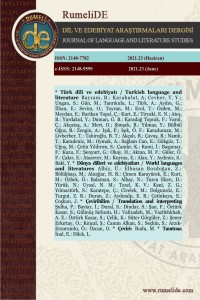Abstract
İffet (1896) ve Son Arzu (1918), Hüseyin Rahmi Gürpınar’ın sonları facia ile biten iki romanıdır. Romanlar; ana karakterleri devirlerine göre eğitimli ve erdemli iki genç kızın, İffet ve Nuruyezdan’ın ölümüyle sona erer. Her iki eser de gerçek hayat hikâyelerine dayanmaktadır. Hüseyin Rahmi Gürpınar, İffet romanında olayın kahramanlarından biri olduğunu eserin önsözünde açıklar. Son Arzu’nun hikâyesi ise Nuruyezdan’ın eşi tarafından kendisine aktarılmıştır. Yazarın bu romanlarla öncelikle dönemin toplumsal yapısını gözler önüne sermek istediği anlaşılmaktadır. Toplumun ahlak anlayışı ise sorgulanan diğer bir kavram olarak ortaya çıkar. İffet romanı özelinde romantizm ile realizmin irdelendiği görülür. Son Arzu özelinde ise eski devrin düşünce biçiminin, durağanlığının eleştirisi yapılır. Kadın hakları ve kadın erkek ilişkileri diğer eleştiri konularıdır. Tüm bu tartışmaların odak noktasını oluşturan asıl temaysa hayal ile hakikat arasındaki karşıtlıkla şekillenir. Her iki romanda da iyi örnek olarak gösterilebilecek çok az kişi varken, erdem sahibi iki kadın toplumun gözünde ahlaksız konumuna düşmüşlerdir. Hüseyin Rahmi Gürpınar’ın İffet ve Son Arzu romanları gerçekçilikle ilgili zayıf noktalarına rağmen evin içi ile sokak arasında kurduğu simgesel zıtlıklarla dikkat çeker. Buna göre evin içi, gerçek hayattan kopukluğu ile “hayal”in, sokak ise “hakikat”in temsilidir. Evdeki diyaloglarda, mektuplarda görülen dil ne kadar erdemli ise, sokağın dili o kadar gayriahlakidir. Ev, eski düzeni ifade ederken ne kadar yıpranmış ya da yüzeyselse, sokakta akan hayat o kadar gerçektir. Kahramanların evlerinde kurguladıkları aşk ne kadar yüce ise, dışarıda karşılaşılan duygu sadece cinsellik üzerinedir. Yazarın büyük başarısı, hayal ve hakikat temi çevresinde oluşturduğu bu zıtlığı ustalıkla eserlerine aktarmış olmasıdır.
References
- Gürpınar, Hüseyin R. (2011) İffet. Everest.
- Gürpınar, Hüseyin R. (2015) Son arzu. Paper Sense.
- Özge B. (2013) İffet’te Emile Zola ve naturalizm etkisi. Folklor/Edebiyat, 19 (76), 233 – 239.
- Serdar, Ali (2007). Hüseyin Rahmi Gürpınar’ın romanlarında ahlak sorunsalı [Yayınlanmamış doktora tezi]. Bilkent Üniversitesi Ekonomi ve Sosyal Bilimler Enstitüsü.
Abstract
İffet (1896) and Son Arzu (1918) are two novels of Hüseyin Rahmi Gürpınar, whose ends with tragedy. The novels end with the death of two young girls, İffet and Nuruyezdan, whose main characters are educated and virtuous according to their times. Both works are based on real life stories. Hüseyin Rahmi Gürpınar explains in the preface of the work that he is one of the heroes of the event in his novel İffet. The story of the Son Arzu was conveyed to him by Nuruyezdan's wife. It is understood that the author wanted to reveal the social structure of the era with these novels. The ethics of the society emerges as another questioned concept. It is seen that romance and realism are examined in the novel of İffet. In the case of the Son Arzu, the way of thinking and the stagnation of the old age is criticized. Women's rights and women-men relations are other criticisms. The main theme, which is the focus of all these discussions, is shaped by the opposition between imagination and truth. While there are very few who can be set as good examples in both novels, two virtuous women have become immoral in the eyes of society. Despite their weaknesses in realism, Hüseyin Rahmi Gürpınar's novels Son Arzu and İffet attract attention with the symbolic contrasts they establish between the interior of the house and the street. According to this, the interior of the house is the representation of “dream” with its disconnection from real life, and the street is the representation of “truth”. The more virtuous the language seen in the dialogues and letters at home, the more immoral the language of the street. Home; the worn or superficial it is in expressing the old order, the more real is the life flowing on the street. No matter how sublime the love the heroes set up in their homes, the emotion encountered outside is only about sexuality. The great success of the author is that he skillfully transferred this contrast he created around the theme of dreams and reality to his works.
References
- Gürpınar, Hüseyin R. (2011) İffet. Everest.
- Gürpınar, Hüseyin R. (2015) Son arzu. Paper Sense.
- Özge B. (2013) İffet’te Emile Zola ve naturalizm etkisi. Folklor/Edebiyat, 19 (76), 233 – 239.
- Serdar, Ali (2007). Hüseyin Rahmi Gürpınar’ın romanlarında ahlak sorunsalı [Yayınlanmamış doktora tezi]. Bilkent Üniversitesi Ekonomi ve Sosyal Bilimler Enstitüsü.
Details
| Primary Language | Turkish |
|---|---|
| Subjects | Linguistics |
| Journal Section | Turkish language, culture and literature |
| Authors | |
| Publication Date | June 21, 2021 |
| Published in Issue | Year 2021 Issue: 23 |


